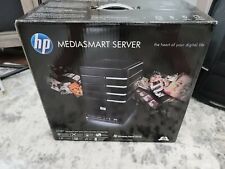
- #Hp Mediasmart Server Ex470 Whs 2011 Mac Or PC
- #Hp Mediasmart Server Ex470 Whs 2011 Install The HP
- #Hp Mediasmart Server Ex470 Whs 2011 Upgrade Without Losing
Hp Mediasmart Server Ex470 Whs 2011 Mac Or PC
The minimum 2GB of RAM) A copy of Windows Home Server 2011 (thanks Technet). Buy HP MediaSmart EX495, Windows Home Server w/ Intel Pentium Dual Core 2.5. The 1,000 GB hard drive helps to expand the computer space for photos, software, and search indexes without. Link together up to 10 Mac or PC computers to one server for easy data storage and sharing. HP MediaSmart servers use 2.2 GHz Intel Celeron processing to deliver the highest-powered streaming, hosting, and file storage solutions.
Hp Mediasmart Server Ex470 Whs 2011 Upgrade Without Losing
HP MediaSmart EX495 - Review 2011 - PCMag India.Bye bye Microsoft Windows Home Server. Old title: hp mediasmart server ex470. External drives, which connect via USB ports (three on the front and one in back) as well as an eSATA port in the back, can vary in storage size and provide easy expandability.Rolling out Windows Home Server with a HP MediaSmart Server. A few praised features of Windows Home Server when it launched in 2007 were:The server's four bays accept drives of any capacity (the EX470 I tested comes with one 500GB unit), but the capacities must match. If you’re looking for an upgrade without losing features, look no further than Amahi. However, WHS 2011 removed some key features.

And even if your entertainment center can hold it, you've also got to think a bit about future expansion. It's not well designed for slipping into an entertainment center, for example. That means wherever you place your HP MediaSmart right now had better be near an Ethernet cable.Another thing to consider is that even though the MediaSmart is headless, it's still built as a super-mini-tower.
Hp Mediasmart Server Ex470 Whs 2011 Install The HP
Not thinking ahead here is a great way to turn your slick entertainment area into a rat's nest of cables.— Next: Plunging InAfter unboxing the MediaSmart, all I had to do was power it up and connect it to my simulated home network, then install the HP Windows Home Server software on at least one Windows PC on the network. That's a no-brainer, but then those external boxes will require data and, probably, power cables, too. Adding an external drive is simply a matter of connecting the drive and waiting for Windows Home Server to add it to the overall storage limit.
My Mac, for example, saw the MediaSmart just fine and even allowed its user to access a protected folder. As a basic NAS, the MediaSmart works fine over standard IP with no client software. This last is required if you want Windows Home Server to do things like remote control, advanced backup, and PC management.To make full use of the MediaSmart, you need to install the HP software, though it's worth noting that computers on the network don't require it to access the device. One is a management console (for the MediaSmart) that you can activate from the task bar another is an encrypted network session manager that runs on top of TCP/IP. I tried the standard software just for grins and came up empty.The software installs several programs.
Just keep clicking on Okay and have a little patience. The first set of software updates takes a few minutes, as both Microsoft and HP vie for software update time. This is standard Windows Home Server stuff, though HP also adds its own HP Update, which keeps track of MediaSmart updates.
You'll also see an LED brightness control and an iTunes Server, which are HP-only. To access HP-specific functions, you finish the installation wizard and open the main administration console.You'll see links to software updates, remote-access settings, basic media serving via WMC, and photo web-share settings—again, standard WHS stuff. HP hasn't done much to change this—a good thing.
It looks as if it has also done some work on the user interface, which is accessible off the main console via a "Settings for iTunes" icon. Turns out this is based on the Firefly Media Server, an open-source project that HP has WHS-ified as an add-on. Cute for about 90 seconds, then my ADD kicked in.The iTunes Server is a different matter.
With 32MB files, the server managed to transfer at 123 MBps, slowing to 47.2 MBps with 1GB files. The MediaSmart did surprisingly well in this scenario, though its performance tended to drop with increases in file size. This ran on a Windows XP Pro desktop connected to the MediaSmart's Gigabit Ethernet port via a Gigabit Netgear GSM7324 switch. Internet access was through a DSL modem connected to a dedicated line.I tested the MediaSmart with the IoZone file system benchmarking tool.

Fortunately, all of these will be addressable via software upgrades, so there's no need to wait on purchasing. HP says it will be fleshing out this product line in the coming months, so we can hope to see better integration with media servers, a tweak for print serving, and some solution for backing up the server—not just the clients.


 0 kommentar(er)
0 kommentar(er)
